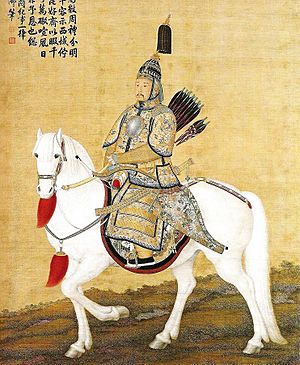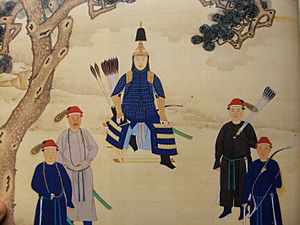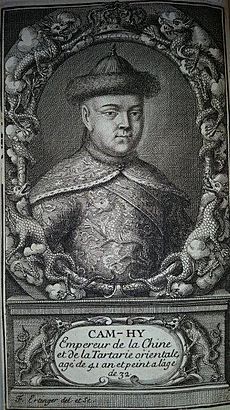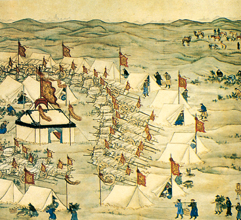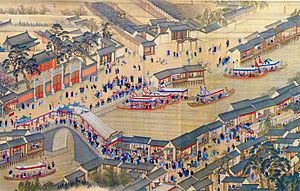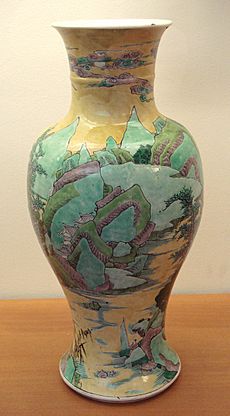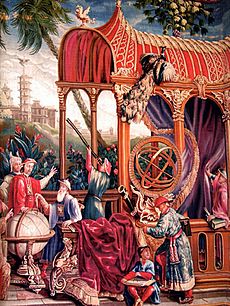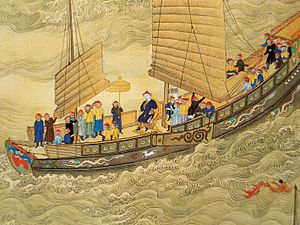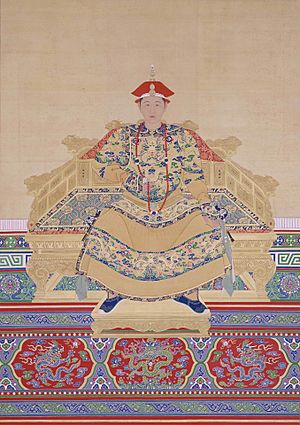Kangxi Emperor facts for kids
Quick facts for kids Kangxi Emperor康熙帝 |
|||||||||||||||||
|---|---|---|---|---|---|---|---|---|---|---|---|---|---|---|---|---|---|
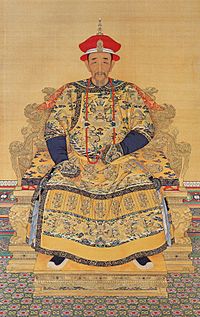 |
|||||||||||||||||
| Emperor of the Qing dynasty | |||||||||||||||||
| Reign | 5 February 1661 – 20 December 1722 | ||||||||||||||||
| Predecessor | Shunzhi Emperor | ||||||||||||||||
| Successor | Yongzheng Emperor | ||||||||||||||||
| Regents | Sonin (1661–1667) Ebilun (1661–1667) Suksaha (1661–1667) Oboi (1661–1669) |
||||||||||||||||
| Born | Aisin-Gioro Xuanye (愛新覺羅·玄燁) 4 May 1654 (順治十一年 三月 十八日) Jingren Palace, Forbidden City |
||||||||||||||||
| Died | 20 December 1722 (aged 68) (康熙六十一年 十一月 十三日) Qingxi Shuwu, Garden of Eternal Spring |
||||||||||||||||
| Burial | Jing Mausoleum, Eastern Qing tombs | ||||||||||||||||
| Wife |
Lady Heseri, Empress Xiaochengren
(m. 1665; died 1674)Lady Niohuru, Empress Xiaozhaoren
(m. 1665; died 1678)Lady Tunggiya, Empress Xiaoyiren
(died 1689)Lady Uya, Empress Xiaogongren
(before 1722) |
||||||||||||||||
| Issue | Yunzhi Yunreng, Prince Limi of the First Rank Yunzhi, Prince Chengyin of the Second Rank Yongzheng Emperor Yunqi, Prince Hengwen of the First Rank Yunyou, Prince Chundu of the First Rank Yunsi Yuntang Yun'e Yuntao, Prince Lüyi of the First Rank Yinxiang, Prince Yixian of the First Rank Yunti, Prince Xunqin of the Second Rank Yunxu, Prince Yuke of the Second Rank Yunlu, Prince Zhuangke of the First Rank Yunli, Prince Guoyi of the First Rank Yunyi Yunxi, Prince Shenjing of the Second Rank Yunhu Yunqi Yunbi, Prince Xianke of the First Rank Princess Rongxian of the First Rank Princess Duanjing of the Second Rank Princess Kejing of the First Rank Princess Wenxian of the First Rank Princess Chunque of the First Rank Princess Wenke of the Second Rank Princess Quejing of the Second Rank Princess Dunke of the Second Rank |
||||||||||||||||
|
|||||||||||||||||
| House | Aisin Gioro | ||||||||||||||||
| Dynasty | Qing | ||||||||||||||||
| Father | Shunzhi Emperor | ||||||||||||||||
| Mother | Empress Xiaokangzhang | ||||||||||||||||
| Kangxi Emperor | |||||||||||||||||||||||
|---|---|---|---|---|---|---|---|---|---|---|---|---|---|---|---|---|---|---|---|---|---|---|---|
| Chinese name | |||||||||||||||||||||||
| Chinese | 康熙帝 | ||||||||||||||||||||||
| Literal meaning | Emperor of the Era of Health and Glory | ||||||||||||||||||||||
|
|||||||||||||||||||||||
| Mongolian name | |||||||||||||||||||||||
| Mongolian Cyrillic | ᠡᠩᠭᠡ ᠠᠮᠤᠭᠤᠯᠠᠩ ᠬᠠᠭᠠᠨ Энх амгалан хаан |
||||||||||||||||||||||
|
|||||||||||||||||||||||
| Manchu name | |||||||||||||||||||||||
| Manchu script | ᡝᠯᡥᡝ ᡨᠠᡳᡶᡳᠨ ᡥᡡᠸᠠᠩᡩᡳ |
||||||||||||||||||||||
| Möllendorff | Elhe Taifin Hūwangdi | ||||||||||||||||||||||
The Kangxi Emperor (born Xuanye on May 4, 1654 – died December 20, 1722) was a very important ruler of China. He was the third emperor of the Qing dynasty, and he ruled from 1661 to 1722.
He ruled for 61 years, which is the longest time any emperor has ever ruled in Chinese history. He became emperor when he was only seven years old. For the first six years, powerful helpers called regents and his grandmother, the Grand Empress Dowager Zhaosheng, helped him rule.
Many people think the Kangxi Emperor was one of China's best emperors. He stopped a big rebellion called the Revolt of the Three Feudatories. He also made sure that Taiwan and some Mongol groups in the north became part of the Qing Empire. He even stopped Russian expansion near the Amur River.
The Kangxi Emperor's rule brought a long period of peace and wealth to China after many years of war. This time is known as the "Prosperous Era of Kangxi and Qianlong." His court also created important books, like the Kangxi Dictionary and a huge collection of poems called Quan Tangshi.
Contents
Becoming Emperor: Kangxi's Early Life
The Kangxi Emperor was born on May 4, 1654, in the Forbidden City in Beijing. His birth name was Xuanye. He became emperor on February 7, 1661, when he was just seven years old. His special era name, "Kangxi," started being used on February 18, 1662.
A historian named Herbert Giles described the Kangxi Emperor as tall and strong. He loved hunting and had bright eyes, though his face showed marks from smallpox.
Before Kangxi became emperor, four powerful men, including Oboi, were chosen to help rule. Oboi became very powerful and even had another regent, Suksaha, put to death. The young Kangxi Emperor had to accept this for a while.
In 1662, the regents ordered a "Great Clearance" in southern China. This meant moving people away from the coast. They did this to fight against a group loyal to the old Ming dynasty, led by a general named Koxinga from Taiwan.
In 1669, Kangxi, with help from his grandmother, arrested Oboi. This is when Kangxi truly began to rule the empire himself. He focused on three main problems: controlling floods on the Yellow River, fixing the Grand Canal, and stopping the Revolt of the Three Feudatories in southern China. His grandmother was very important to him, and he took care of her until she passed away in 1688.
Kangxi's Military Successes
Qing Dynasty Army Power
The main army of the Qing Empire was called the Eight Banners. It was smaller during Kangxi's time than it had been before. However, the Green Standard Army was still very strong, with many skilled generals.
Kangxi used a strict military system. For example, a commander who came back from a battle alone (meaning all his soldiers had died) would be put to death. This rule made sure that both commanders and soldiers fought bravely. Later, under other emperors, this strictness was relaxed.
Stopping the Three Feudatories Rebellion
After the Qing dynasty took over China in 1644, large parts of the south were given to three former Ming generals. In 1673, these areas were controlled by Wu Sangui, Geng Jingzhong, and Shang Zhixin. Kangxi decided to make these princes give up their lands and return to Manchuria. This decision started a rebellion that lasted eight years. Kangxi later felt bad about the lives lost during this revolt.
Wu Sangui's forces took over much of southwest China. Kangxi used generals like Zhou Peigong and Tuhai to stop the rebellion. He also offered forgiveness to ordinary people caught in the war. Kangxi mainly used Han Chinese soldiers from the Green Standard Army to defeat the rebels. The rebellion ended in 1681 with a Qing victory.
Taking Control of Taiwan
In 1683, the Qing navy, led by Admiral Shi Lang, defeated the Ming loyalists on Taiwan. These loyalists were part of the Kingdom of Tungning. Koxinga's grandson, Zheng Keshuang, surrendered Taiwan a few days later. Taiwan then became part of the Qing Empire.
Many Ming princes had joined the Zheng dynasty on Taiwan. The Qing sent most of them back to mainland China. However, the Prince of Ningjing and his five wives chose to die rather than be captured. Their palace was later turned into a temple for the goddess Mazu. Kangxi approved this and honored Mazu for supposedly helping the Qing invasion.
After the rebellion ended, Kangxi allowed people to resettle the coasts of Fujian and Guangdong. This led to many Hakka people moving there.
Dealing with Russia and Mongolia
In the 1650s, the Qing Empire had fights with Russia along the Amur River. The Qing gained control of the area after a battle at Albazin.
The Russians tried to invade again in the 1680s. After battles and talks, the Treaty of Nerchinsk was signed in 1689. This treaty set the border between Russia and China.
The Khalkha Mongols in Outer Mongolia were independent but paid tribute to the Qing. However, a conflict between Mongol groups led to a war with the Dzungar Khanate. In 1688, the Dzungar chief, Galdan Boshugtu Khan, attacked the Khalkha. The Khalkha leaders asked the Qing Empire for help and agreed to become part of the Qing.
In 1690, the Dzungars and Qing forces fought at the Battle of Ulan Butung. The Qing won this battle. In 1696 and 1697, the Kangxi Emperor personally led campaigns against the Dzungars. His army defeated Galdan's forces, and Galdan died the next year.
Qing Control in Tibet
In 1701, the Kangxi Emperor ordered his forces to take back towns in western Sichuan that Tibetans had captured. The Qing army took Dartsedo, securing the border with Tibet and the important trade route called the Tea Horse Road.
A Tibetan leader had hidden the death of the 5th Dalai Lama for many years. He also had ties with the Dzungars, who were enemies of the Qing. This made Kangxi very unhappy. Eventually, the Tibetan leader was overthrown and killed in 1705. Kangxi then appointed another leader, Lha-bzang Khan, as the ruler of Tibet.
The Dzungar Khanate invaded Tibet in 1717, taking control of Lhasa and killing Lha-bzang Khan. The Dzungars held Lhasa for three years. The Qing did not take control of Lhasa until 1720, when Kangxi sent a larger army to defeat the Dzungars.
Kangxi's Economic and Cultural Impact
Managing the Empire's Money
The amount of money in the national treasury changed during Kangxi's rule.
- 1668: 14.9 million taels (an old Chinese unit of money)
- 1692: 27.3 million taels
- 1702–1709: around 50 million taels
- 1721 (near the end of his rule): 32.6 million taels
The treasury's money went down in his later years because of big military costs and some corruption. To fix this, Kangxi gave advice to his son, who would become the Yongzheng Emperor, on how to manage the economy better.
Cultural Achievements and Learning
During his reign, the Kangxi Emperor ordered the creation of a dictionary of Chinese characters. This book became known as the Kangxi Dictionary. He did this to gain support from Chinese scholars. Many scholars were still loyal to the old Ming dynasty and didn't want to work for the Qing. By asking them to work on the dictionary, Kangxi slowly got them to take on more important roles in the government.
In 1705, Kangxi also ordered a huge collection of Tang poetry to be put together. This was called the Quan Tangshi.
Kangxi was also very interested in Western technology. He learned about it from Jesuit missionaries like Ferdinand Verbiest. Kangxi often met with these missionaries. He even had Karel Slavíček make the first accurate map of Beijing.
From 1711 to 1723, an Italian priest named Matteo Ripa worked as a painter at the Qing court. He later returned to Italy with four young Chinese Christians. He wanted to train them to become priests and send them back to China. This started the Collegio dei Cinesi, which was the first school in Europe to study China.
Kangxi was also the first Chinese emperor to play a Western musical instrument. A Jesuit named Thomas Pereira taught him how to play the harpsichord. China's famous blue and white porcelain also reached its best quality during Kangxi's time.
Christianity in China
In the early years of Kangxi's rule, Jesuits played a big role in the imperial court. They used their knowledge of astronomy to run the imperial observatory. They also helped Kangxi with gun making and artillery, which helped the Qing army win battles.
Kangxi liked the Jesuits because they were respectful and spoke Chinese well. In 1692, he allowed Christianity to be practiced in China. He issued an Edict of Toleration, which protected Christian churches and missions.
However, a disagreement started about whether Chinese Christians could still take part in traditional Chinese ceremonies, like honoring ancestors. The Jesuits said it was okay, but other Christian groups disagreed. The Pope agreed with the stricter view and sent a representative to tell Kangxi that Chinese rites were forbidden. Kangxi was upset by this and, in 1715, officially stopped Christian missions in China.
Challenges with Succession
During Kangxi's reign, there was a long struggle among his sons over who would become the next emperor. This was known as the "Nine Lords' War."
In 1674, Kangxi's first wife died while giving birth to his son, Yinreng. When Yinreng was two years old, Kangxi named him the crown prince. This was a Chinese custom to help keep things stable. Kangxi personally taught Yinreng, hoping he would be a perfect successor.
However, Yinreng did not turn out as his father hoped. Kangxi saw many problems with his son's behavior. In 1707, Kangxi decided to remove Yinreng as crown prince. He put his oldest son, Yinzhi, in charge of watching Yinreng. Yinzhi then suggested that Kangxi should execute Yinreng. Kangxi was very angry and took away Yinzhi's titles.
Kangxi later thought that Yinreng might have been framed. So, in 1709, he made Yinreng crown prince again. He said Yinreng had been acting strangely because of a mental illness.
In 1712, during Kangxi's last trip to the south, Yinreng tried to gain power again. He even tried to force Kangxi to give up the throne when he returned to Beijing. But Kangxi found out about the plan. He was so angry that he removed Yinreng as crown prince for good and placed him under house arrest. After this, Kangxi said he would not name another crown prince while he was alive. He said his final will would be kept in a locked box and only opened after his death.
After Yinreng was removed, some princes supported the 14th prince, Yinti. Others supported the 4th prince, Yinzhen. These groups were called the "Eighth Lord Party" and the "Fourth Lord Party."
Kangxi's Death and the Next Emperor
On the evening of December 20, 1722, just before he died, the Kangxi Emperor called seven of his sons to his bedside. After Kangxi passed away, a trusted official announced that the emperor had chosen the fourth prince, Yinzhen, as the new emperor. Yinzhen then became known as the Yongzheng Emperor. Kangxi was buried at the Eastern Qing Tombs in Zunhua, Hebei.
There is a story that Kangxi wanted his 14th son, Yinti, to be the next emperor, but Yinzhen changed the will. However, historians have shown this story is not true.
Kangxi's Personality and Achievements
The Kangxi Emperor was very important in making the Qing dynasty strong and stable. When he became emperor in 1661, the Qing had almost finished taking over China. Kangxi completed this takeover, stopped all major military threats, and improved the government system.
Kangxi was a hard worker. He woke up early and went to bed late, reading and replying to many messages every day. He met with his advisors and held meetings. During wartime, he would even read war reports late into the night or lead campaigns himself.
Kangxi created a special way for secret messages to be sent directly to him from trusted officials. These messages were in locked boxes that only he and the official could open. This system helped him get uncensored information and eventually led to the creation of the Grand Council. This council dealt with important matters, especially military ones.
Kangxi also encouraged Chinese scholars to work with the Qing government. He did this even though many scholars were still loyal to the old Ming dynasty. He supported Confucian learning and made sure that government exams were held regularly. He personally sponsored the writing of the Ming Official History, the Kangxi Dictionary, and other large collections of Chinese literature. He studied Confucian classics and Chinese calligraphy to show he was a "sage ruler."
In his military campaigns, especially against the Dzungar Mongols, Kangxi showed he was a skilled commander. He cared deeply for his soldiers and had a strong relationship with his generals.
Because of the peace and growth in China, Kangxi was able to reduce taxes. In 1712, he even froze the land tax and labor duties completely.
Family Life
The Kangxi Emperor had many wives, concubines, and children. Here are some of the most important ones:
Empresses
- Empress Xiaochengren (died 1674): Mother of his second surviving son, Yunreng, who was named crown prince.
- Empress Xiaozhaoren (died 1678)
- Empress Xiaoyiren (died 1689)
- Empress Xiaogongren (died 1723): Mother of the Yongzheng Emperor, who became the next emperor.
Imperial Noble Consorts
- Imperial Noble Consort Quehui (died 1743)
- Imperial Noble Consort Jingmin (died 1699): Mother of Yinxiang, a very important prince.
- Imperial Noble Consort Dunyi (died 1768)
Noble Consorts
- Noble Consort Wenxi (died 1694)
- Consort Hui (died 1732)
- Consort Yi (died 1733)
- Consort Rong (died 1727)
- Consort Ping (died 1696)
- Consort Liang (died 1711): Mother of Yunsi, a prince involved in the succession disputes.
- Consort Xuan (died 1736)
- Consort Cheng (died 1740)
- Consort Shunyimi (died 1744)
- Consort Chunyuqin (died 1754)
- Consort Ding (died 1757)
Kangxi in Popular Culture
The Kangxi Emperor is a popular figure in Chinese stories, movies, and TV shows.
Books and Novels
- Kangxi Dadi (The Great Kangxi Emperor): A historical novel that tells a romanticized version of his life.
- The Deer and the Cauldron: A famous adventure novel where the Kangxi Emperor becomes close friends with the main character, Wei Xiaobao, when they are young. Wei helps the emperor in many important historical events.
Movies and TV Shows
The Kangxi Emperor has been played by many actors in different TV series and films. These often show his adventures, his struggles with his sons, or his relationships with others.
| Year | Region | Title | Type | Kangxi Emperor actor | Notes |
|---|---|---|---|---|---|
| 1984 | Hong Kong | The Deer and the Cauldron | Television | Andy Lau | A Hong Kong television series adapted from The Deer and the Cauldron |
| 1995 | Hong Kong | The Ching Emperor(天子屠龍) | Television | Julian Cheung | TVB series |
| 1998 | Hong Kong | The Deer and the Cauldron | Television | Steven Ma | Hong Kong television series adapted from The Deer and the Cauldron |
| 2000 | Hong Kong/Taiwan | The Duke of Mount Deer (小宝与康熙) | Television | Patrick Tam | Adapted from Louis Cha's novel The Deer and the Cauldron. |
| 2001 | Mainland China | Kangxi Dynasty | Television | Chen Daoming | Adapted from Er Yuehe's novel The Great Kangxi Emperor |
| 2006 | Mainland China | Secret History of Kangxi (康熙秘史) | Television | Xia Yu | The fourth instalment in a four-part Chinese television series about the early history of the Qing dynasty |
| 1998–2007 | Mainland China | Records of Kangxi's Travel Incognito | Television | Zhang Guoli | A five-season Chinese television series about the Kangxi Emperor's inspection tours to southern China. During some of his tours, the emperor disguised himself as a commoner to conceal his identity so that he can blend into society and understand commoners' daily lives better. |
| 2008 | Mainland China | The Deer and the Cauldron | Television | Wallace Chung | Chinese television series adapted from The Deer and the Cauldron |
| 2011 | Mainland China | Palace | Television | Kent Tong | Chinese television series set in the Kangxi era of the Qing dynasty. A woman from the 21st century accidentally travels back in time to the 18th century. |
| Hong Kong | The Life and Times of a Sentinel | Television | Power Chan | Hong Kong television series about Fuquan attempting to overthrow the Kangxi Emperor | |
| Mainland China | Scarlet Heart | Television | Damian Lau | Chinese television series set in the Kangxi era of the Qing dynasty. A woman from the 21st century accidentally travels back in time to the 18th century. | |
| 2013 | Mainland China | The Palace | Film | Winston Chao | |
| 2014 | Mainland China | The Deer and the Cauldron | Television | Wei Qianxiang | Chinese television series adapted from The Deer and the Cauldron |
| 2014 | Hong Kong | Gilded Chopsticks | Television | Elliot Ngok | Hong Kong television series about a chef who befriends Yinzhen (the future Yongzheng Emperor) and aids him in the power struggle for the succession. |
| 2016 | Mainland China | Chronicle of Life | Television | Hawick Lau | Chinese television series about a romance between the Kangxi Emperor and his childhood love. |
| 2017 | Mainland China | Legend of Dragon Pearl | Television | Qin Junjie | Chinese television series about Kangxi at the beginning of his reign. |
| 2019 | Mainland China | Dreaming Back to the Qing Dynasty | Television | Liu Jun |
Video Games
- Age of Empires III: The Asian Dynasties: The Kangxi Emperor is a leader for the Chinese civilization in this strategy game.
- Call Me Emperor: Kangxi appears as a minister in this role-playing strategy game.
Images for kids
See also
 In Spanish: Kangxi para niños
In Spanish: Kangxi para niños




